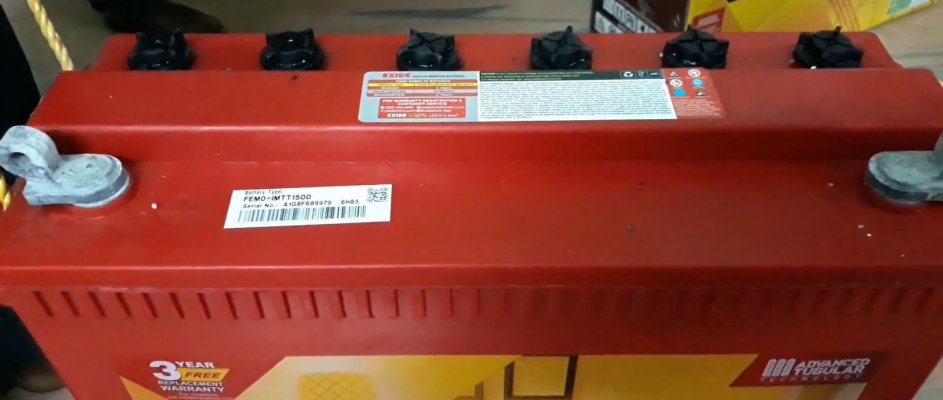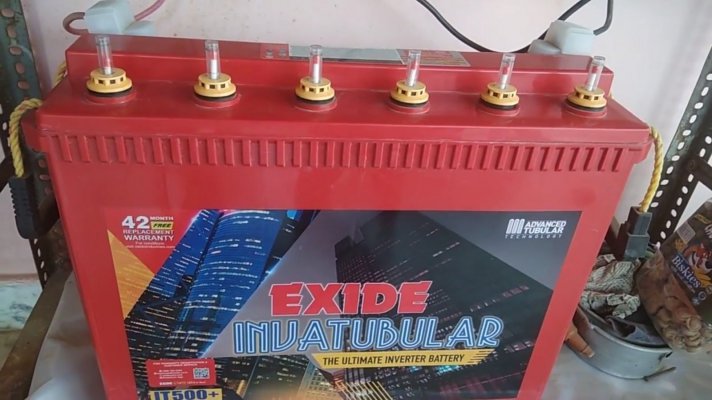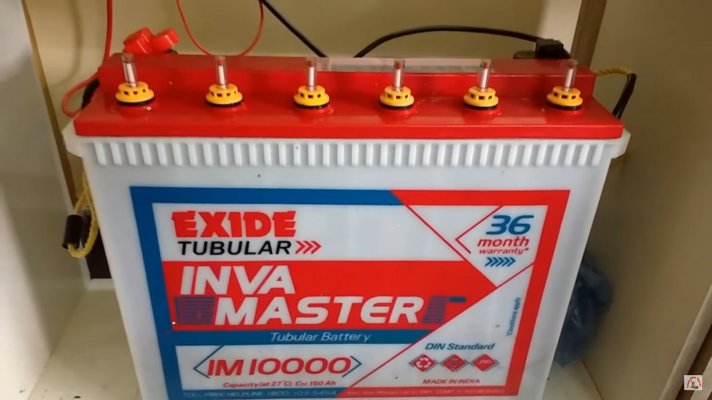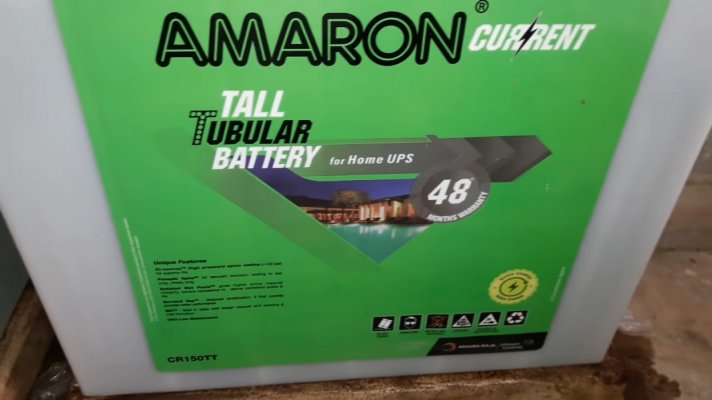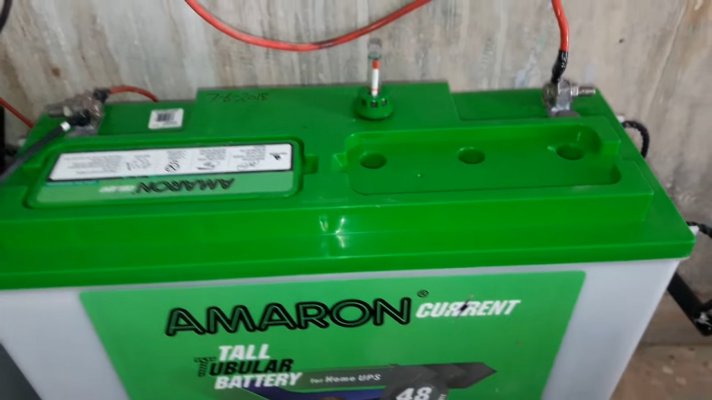Looking for a home UPS that is smart
- Thread starter blr_p
- Start date
You are using an out of date browser. It may not display this or other websites correctly.
You should upgrade or use an alternative browser.
You should upgrade or use an alternative browser.
Yes it's good enough for batteries, the fact that exide themself sell it. The price is high because my dad didn't know how much it costed,without the MRP price he had no clue.
I have seen prices anywhere between indiamart (mostly dealer price 60) to 90(moglix) + gst.
You get those regular green or blue can with distill water at several places. The last time I bought one, it failed the visual inspection test, had lot of floating particles and even plastic shavings from the container/can itself. Which is why over the past few years I used to buy only the 1 liter bottle versions, so that you can inspect it before buying.
Earlier like 5 years back when shell pumps used to sell them, the laboratory from which they got, had no floating particles or had higher quality control for the ones designated for shell pumps. They where made in Bangalore.
Now days they are fakes selling everwhere, with tap water or RO water with 2 digit TDS.
The guy in the video is a idiot, the float caps can easily be damaged , in my village they had a luminous battery, the fill holes '+ ' shaped caps where stripped after several years of use or using improper tools to remove. After another year they have also broken of multiple float caps, by trying to open that.
The acid detoriates the plastic caps, making them brittle.
I have seen prices anywhere between indiamart (mostly dealer price 60) to 90(moglix) + gst.
You get those regular green or blue can with distill water at several places. The last time I bought one, it failed the visual inspection test, had lot of floating particles and even plastic shavings from the container/can itself. Which is why over the past few years I used to buy only the 1 liter bottle versions, so that you can inspect it before buying.
Earlier like 5 years back when shell pumps used to sell them, the laboratory from which they got, had no floating particles or had higher quality control for the ones designated for shell pumps. They where made in Bangalore.
Now days they are fakes selling everwhere, with tap water or RO water with 2 digit TDS.
The guy in the video is a idiot, the float caps can easily be damaged , in my village they had a luminous battery, the fill holes '+ ' shaped caps where stripped after several years of use or using improper tools to remove. After another year they have also broken of multiple float caps, by trying to open that.
The acid detoriates the plastic caps, making them brittle.
blr_p
Quasar
Water out of my aqua guard will pass a visual inspection testYou get those regular green or blue can with distill water at several places. The last time I bought one, it failed the visual inspection test, had lot of floating particles and even plastic shavings from the container/can itself. Which is why over the past few years I used to buy only the 1 liter bottle versions, so that you can inspect it before buying.
Earlier like 5 years back when shell pumps used to sell them, the laboratory from which they got, had no floating particles or had higher quality control for the ones designated for shell pumps. They where made in Bangalore.
Now days they are fakes selling everwhere, with tap water or RO water with 2 digit TDS.

Is there a special spanner key with a philips head to open those caps with a '+' sign ? I've seen people use coinsThe guy in the video is a idiot, the float caps can easily be damaged , in my village they had a luminous battery, the fill holes '+ ' shaped caps where stripped after several years of use or using improper tools to remove. After another year they have also broken of multiple float caps, by trying to open that.
The acid detoriates the plastic caps, making them brittle.
Has to be made out of plastic, metal will damage it over time. Can't find anything online.
Yes, but not the zero tds. Thats the point, even if you see a bottle with clear water, you won't know its tds until you get it home.Water out of my aqua guard will pass a visual inspection test
So, its worth buying exide distillo battery water.
Is there a special spanner key with a philips head to open those caps with a '+' sign ? I've seen people use coins
Has to be made out of plastic, metal will damage it over time. Can't find anything online.
Coin works, which is recomended for removing the caps, but they to eventually strip, poor design and materials(possibly delibrate).
For the completely stripped out caps in the lumionus battery in my village, I took a wood piece, hammered two tiny nails and peirced the caps with it and then turned it CCW,to remove them. I then found a used cap from a discarded battery from a battery dealer.
In the case of my old exide EL which had the micro porous vent cap, couldn't find any replacement caps, so I just gluded them back, barely tightened them, it's been coming off and I glue them back. Will eventualy 3d print caps.
blr_p
Quasar
Sure, its just that one does not think to do a visual inspection test with distilled water. The assumption is it will be clear but as you've found out some times the bottling process isn't very good.Yes, but not the zero tds. Thats the point, even if you see a bottle with clear water, you won't know its tds until you get it home.
So, its worth buying exide distillo battery water.
Now I can immediately see the value of doing a visual inspection test.
Was looking at a video for the C10 exide solatubular and it does not have a second cap behind the float. The EL has it, the invatubular has it so why did exide leave it out of the 150AH C10 solatubular (the one with an 'L' at the end of the model#).Coin works, which is recomended for removing the caps, but they to eventually strip, poor design and materials(possibly delibrate).
For the completely stripped out caps in the lumionus battery in my village, I took a wood piece, hammered two tiny nails and peirced the caps with it and then turned it CCW,to remove them. I then found a used cap from a discarded battery from a battery dealer.
In the case of my old exide EL which had the micro porous vent cap, couldn't find any replacement caps, so I just gluded them back, barely tightened them, it's been coming off and I glue them back. Will eventualy 3d print caps.

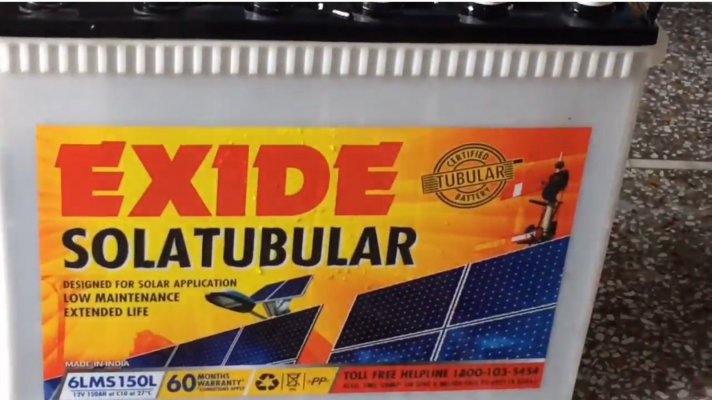
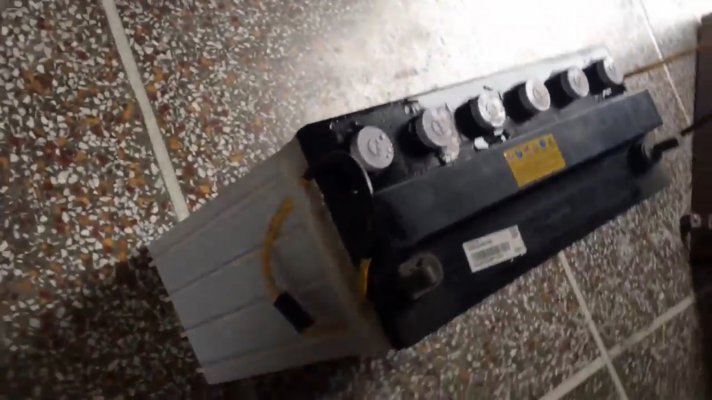
Imagine the 200Ah wil be the same too. Will have to insist on a spare set of floats per battery. I can't see the originals lasting very long with maintenance.
Last edited:
rdst_1
Juggernaut
Why don't these companies just provide a semi-transparent indicator of min and max levels on the sides like the ones provided on my earlier motorcycle batteries. They were so easy to check and fill-up.
I might end up getting an inverter after all for my dairy unit. I had earlier given up and switched to getting a generator. However, since I have relegated the heating loads from electric to LPG, my load requirements now have come down to just running a few motors and that means that running a generator might be inefficient. I will get the final number once I finalise on the machines, but I think I might get away with using an inverter or two. I will however need an inverter which can handle high inrush current and that too even while already running another motor. Will have to see if something like that is available.
I might end up getting an inverter after all for my dairy unit. I had earlier given up and switched to getting a generator. However, since I have relegated the heating loads from electric to LPG, my load requirements now have come down to just running a few motors and that means that running a generator might be inefficient. I will get the final number once I finalise on the machines, but I think I might get away with using an inverter or two. I will however need an inverter which can handle high inrush current and that too even while already running another motor. Will have to see if something like that is available.
Bummer, even the newer Exide EL doesn't have the second cap. So I guess they changed the design, the casting is the same now for all tall tubular batteries from them, Including the c10 6lms 3 and 5 year warranty solar, EL range, El master and inva tubular.Was looking at a video for the C10 exide solatubular and it does not have a second cap behind the float. The EL has it, the invatubular has it so why did exide leave it out of the 150AH C10 solatubular (the one with an 'L' at the end of the model#).
View attachment 79136 View attachment 79137
Imagine the 200Ah wil be the same too. Will have to insist on a spare set of floats per battery. I can't see the originals lasting very long with maintenance.
EL plus I have been told there is no supply by two dealers.
I guess they changed the design, more cost cutting.

How do they expect the user to remove the float. If it doesn't budge, using a wrench or pliers will cause damage.
blr_p
Quasar
How do you decide when a generator makes sense and when it does not ?Why don't these companies just provide a semi-transparent indicator of min and max levels on the sides like the ones provided on my earlier motorcycle batteries. They were so easy to check and fill-up.
I might end up getting an inverter after all for my dairy unit. I had earlier given up and switched to getting a generator. However, since I have relegated the heating loads from electric to LPG, my load requirements now have come down to just running a few motors and that means that running a generator might be inefficient. I will get the final number once I finalise on the machines, but I think I might get away with using an inverter or two. I will however need an inverter which can handle high inrush current and that too even while already running another motor. Will have to see if something like that is available.
A couple weeks back the power went out for 6h. This can happen but its rare when some problem is there. Fortunately it was during the day, i couldn't tell if the problem was with m house or not so i went asking neighbours and discovered one of them had a 5KVA generator by Kohler. It has a 15ltr tank and the guy told me a litre consumed per hour. That's 15h backup on a full tank. They just stuck it out in the open at the back.
rdst_1
Juggernaut
It depends upon economics and your process flow. My majority load was heating load so I definitely needed a generator. But until I was buying one which automatically turns on, which are quite expensive, they would definitely stop my processes until I would go and switch on the generator. Now I am shifting my heating load to LPG or biomass, so only need the backup to run 2-3 motors and a refrigeration unit. I might still get a cheap generator for emergencies but I can now run the rest of the load on an inverter. The processes might still stop but getting them back on will only take a second. This will help tremendously especially when I will be running the milking machine as a cow doesn't like a break during the milking.How do you decide when a generator makes sense and when it does not ?
A couple weeks back the power went out for 6h. This can happen but its rare when some problem is there. Fortunately it was during the day, i couldn't tell if the problem was with m house or not so i went asking neighbours and discovered one of them had a 5KVA generator by Kohler. It has a 15ltr tank and the guy told me a litre consumed per hour. That's 15h backup on a full tank. They just stuck it out in the open at the back.
A basic generator is pretty cheap - less than 50k for 10kVA but as soon as you add auto-switching, canopy, etc. costs go through the roof. Also, need special permissions from the electricity deptt for a generator which switches on automatically. None for inverter/simple generator.
blr_p
Quasar
I see i've not looked at those models recently, images i had seen from catalogs must be from older models then.Bummer, even the newer Exide EL doesn't have the second cap. So I guess they changed the design, the casting is the same now for all tall tubular batteries from them, Including the c10 6lms 3 and 5 year warranty solar, EL range, El master and inva tubular.
EL plus I have been told there is no supply by two dealers.
I guess they changed the design, more cost cutting.
Plastic wrench ? thing is how tight. Less tight means less wear but also more water loss.How do they expect the user to remove the float. If it doesn't budge, using a wrench or pliers will cause damage.
The flin off grid models have 2x surge for couple of seconds, even more inrush for shorter duration, some models can be paralleled (upto 9 units to 45kw) . Not sure if the motor will run if connected to three inverters, running identical voltage, phase, frequency.
There are three phase models but are expensive.
There are three phase models but are expensive.
They have changed it now. Even then they soon become brittle, perhaps I have to much expectation, my battery cap broke at 8 years, one more in 9th year.I see i've not looked at those models recently, images i had seen from catalogs must be from older models then.
Plastic wrench ? thing is how tight. Less tight means less wear but also more water loss.
Heard they do sell spare floats in the market, Battery Dealers don't stock them, a newer battery sale is a better option for them.
A search in indiamart does show sellers, question is will the thread diameter and pitch match.
rdst_1
Juggernaut
Flin seems to be quite expensive for same capacity when compared to other manufacturers. I might end up buying a custom solution from people who make industrial grade inverters. Have found a few on Indiamart who promise in-rush capable inverters.The flin off grid models have 2x surge for couple of seconds, even more inrush for shorter duration, some models can be paralleled (upto 9 units to 45kw) . Not sure if the motor will run if connected to three inverters, running identical voltage, phase, frequency.
There are three phase models but are expensive.
BTW, do you use or feel the need to use a battery balancer, which balances the voltage across a battery bank.
The cells near the negative terminals have higher water loss and as the battery ages all the cells have different levels. Amaron is step above in cost cutting. Amaron are not that popular for inverter, exide and luminous have higher share in tall tubular batteries.Exide have a a standard design now. Check the Amaron out, just one float. How does that work for a six cell battery ?
The caps remind me of Trojan now. Three in one go. So is this the future design ?
If you look at those picture posted by you, a plastic wrench will be useless, they won't bite enough to rotate them. A metal one, will but will shave of the plastic caps each time.
Yes a battery balancer is a must for anything more then 2 batteries in series. Even if the system uses 2 battery, a battery balancer is recommended.But my Exide C10 EL model, 24v batteries which was maintained by me alone, for the past 9 years are within .05v of each other with no balancer.Flin seems to be quite expensive for same capacity when compared to other manufacturers. I might end up buying a custom solution from people who make industrial grade inverters. Have found a few on Indiamart who promise in-rush capable inverters.
BTW, do you use or feel the need to use a battery balancer, which balances the voltage across a battery bank.
Flin has lite models which don't have the MPPT charge controller, they are similar priced to regular indian brand ones. But I guess for your application custom solution will be a better option.
blr_p
Quasar
Yes this is why i was wondering how a single float works unless there is some common channel at the back. I wonder how such a design keeps the individual cells balanced over time. It cannot and is useless. Regular checking like with the american batteries is the only way. I notice none of Trojan's batteries use floats. Maybe due to durability issues.The cells near the negative terminals have higher water loss and as the battery ages all the cells have different levels. Amaron is step above in cost cutting. Amaron are not that popular for inverter, exide and luminous have higher share in tall tubular batteries.
Problem is all those caps are circular with no straight edges for grip. They should have at least created a hexagonal outline that protruded out some.If you look at those picture posted by you, a plastic wrench will be useless, they won't bite enough to rotate them. A metal one, will but will shave of the plastic caps each time.
What about pliers with hard rubber tips for grip then.
No idea what they where thinking, here is the video of that amaron. The sticker on the amaron say to fill the battery with distill water every 3 months, compared to the 6 to 9 months for exide and luminous.Yes this is why i was wondering how a single float works unless there is some common channel at the back. I wonder how such a design keeps the individual cells balanced over time. It cannot and is useless. Regular checking like with the american batteries is the only way. I notice none of Trojan's batteries use floats. Maybe due to durability issues.
So because of that short top up interval, I guess they are getting away with one float. Hell my old EL doesn't have any floats and I used to fill them every 3 months may every 2 months in summer or during the period of heavy power cuts some 7 to 8 years back, but mine is not a Tall tubular. But interesting design for filling.
Even rubber won't do any good, the other day while I was installing external IP cameras for my house, I tried using my existing heat shrink wrapped pliers(no good) and later cycle tube, to tighten or remove the M22 x 1.5 glands made of plastic and it nearly made them round, you cannot gauge the torque you are giving if you use rubber, sure the rubber tube finally helped in terms of not stripping more, but it was PIA .Problem is all those caps are circular with no straight edges for grip. They should have at least created a hexagonal outline that protruded out some.
What about pliers with hard rubber tips for grip then.
But for battery application, does it have to be that difficult for a routine filling of water. Poor and possibly deliberate design.
Exide does have batteries that are transparent, so you can even know how much sulfation and other material shedding has accumulated in the bottom, which is a common cause of battery failure. As they pile up in the bottom, they eventually touch the + and - plates leading to a short, killing the cell. Those transparent batteries are only available in 2v and when I inquired about the price and quantity, they didn't even bother for my 24 pieces of 200ah requirement and when I asked a competitor in the solar expo regarding the price of those 2v non-transparent battery, Lithium was cheaper lol.Why don't these companies just provide a semi-transparent indicator of min and max levels on the sides like the ones provided on my earlier motorcycle batteries. They were so easy to check and fill-up.
blr_p
Quasar
Here is a load test and his results are longer than what i would expect
He measures a constant current of 23A. This means his load is 23 x 12 = 276W
A 150AH is 1800Wh
So theoretical max will be 1800 / 276 = 6.5h
There is derating since this is a C20 let's say 0.7 , so backup time is 4.5h
Take away 20% losses due to inverter makes it 3.6h
But he gets a run time of 6h with that load when run till flat.
Meaning he gets 92% of theoretical.
hmm ....
But his power meter measures 210W. So the ammeter must be incorrect.
1800/210 = 8.5h
With derating it becomes 6h and with inverter inefficency it becomes 4.8h
Power meter measures 141.09 - 139.87 = 1200kW consumed
Which is 66% of theoretical max, that looks right
Current is constant as it never drops during the video according to that ammeter.
There is one x factor here and that is ambient temperature. If its hot enough the battery could deliver longer than expected. 120%+
He measures a constant current of 23A. This means his load is 23 x 12 = 276W
A 150AH is 1800Wh
So theoretical max will be 1800 / 276 = 6.5h
There is derating since this is a C20 let's say 0.7 , so backup time is 4.5h
Take away 20% losses due to inverter makes it 3.6h
But he gets a run time of 6h with that load when run till flat.
Meaning he gets 92% of theoretical.
hmm ....

But his power meter measures 210W. So the ammeter must be incorrect.
1800/210 = 8.5h
With derating it becomes 6h and with inverter inefficency it becomes 4.8h
Power meter measures 141.09 - 139.87 = 1200kW consumed
Which is 66% of theoretical max, that looks right
Current is constant as it never drops during the video according to that ammeter.
There is one x factor here and that is ambient temperature. If its hot enough the battery could deliver longer than expected. 120%+
Last edited:
rdst_1
Juggernaut
I checked out the Flin range and the inverter that really pulls my heart strings is the Flinfuzion 5kVA Parallel version. The best part about it is that it does realtime load sharing between solar and utilities/batteries. This gives me the option to add solar panels later on and supplement my power needs, especially since the electricity department isn't keen on passing my load requirements without making me pay 5L for a 250kVA transformer upgrade.
The only issue is that it costs double of what a normal 5kVA inverter costs at 67k, but it still seems worth the price for the features it offers especially the load sharing part. Even with the low price of electricity that we have over here, I should be able to recover costs of a solar setup within 7-8 years if the batteries last that long.
The only issue is that it costs double of what a normal 5kVA inverter costs at 67k, but it still seems worth the price for the features it offers especially the load sharing part. Even with the low price of electricity that we have over here, I should be able to recover costs of a solar setup within 7-8 years if the batteries last that long.
Just that you know, the load sharing between utility and solar/battery works like this. Suppose the 5kw solar array is putting out 3kw at a particular time, if the load now is more like 3.5kw, it will take the remaining from battery. If the battery is also depleted or if no battery is connected then it will change over completely to the utility , where it will take 3.5kw from the utility until the load drops below 3kw at which point it will revert back to solar, in the same time while the load is being power by utilty, it will charge the battery using solar only(if set in menu).
The super duper expensive Grid tie smart hybrid flin models on the other hand in the same situation above with 5kw solar array and 3kw output , the 3.5kw load will now only take 500w from the grid. The problem with this model is that it cannot export power to the grid because it's not MNRE approved and it also cannot handle surge/start up current like the off grid models such as Flinfuzion.
The super duper expensive Grid tie smart hybrid flin models on the other hand in the same situation above with 5kw solar array and 3kw output , the 3.5kw load will now only take 500w from the grid. The problem with this model is that it cannot export power to the grid because it's not MNRE approved and it also cannot handle surge/start up current like the off grid models such as Flinfuzion.


